(Page créée avec « {{Tuto Details |Main_Picture=COREMO_TRAILER_-_Community_Repair_Mobile_1.jpg |Main_Picture_annotation={"version":"3.5.0","objects":[{"type":"image","version":"3.5.0","origi... ») |
|||
| (38 révisions intermédiaires par 3 utilisateurs non affichées) | |||
| Ligne 3 : | Ligne 3 : | ||
|Main_Picture_annotation={"version":"3.5.0","objects":[{"type":"image","version":"3.5.0","originX":"left","originY":"top","left":-32,"top":-1,"width":1280,"height":853,"fill":"rgb(0,0,0)","stroke":null,"strokeWidth":0,"strokeDashArray":null,"strokeLineCap":"butt","strokeDashOffset":0,"strokeLineJoin":"miter","strokeMiterLimit":4,"scaleX":0.53,"scaleY":0.53,"angle":0,"flipX":false,"flipY":false,"opacity":1,"shadow":null,"visible":true,"clipTo":null,"backgroundColor":"","fillRule":"nonzero","paintFirst":"fill","globalCompositeOperation":"source-over","transformMatrix":null,"skewX":0,"skewY":0,"crossOrigin":"","cropX":0,"cropY":0,"src":"https://wikifab.org/images/9/9a/COREMO_TRAILER_-_Community_Repair_Mobile_1.jpg","filters":[]}],"height":450,"width":600} | |Main_Picture_annotation={"version":"3.5.0","objects":[{"type":"image","version":"3.5.0","originX":"left","originY":"top","left":-32,"top":-1,"width":1280,"height":853,"fill":"rgb(0,0,0)","stroke":null,"strokeWidth":0,"strokeDashArray":null,"strokeLineCap":"butt","strokeDashOffset":0,"strokeLineJoin":"miter","strokeMiterLimit":4,"scaleX":0.53,"scaleY":0.53,"angle":0,"flipX":false,"flipY":false,"opacity":1,"shadow":null,"visible":true,"clipTo":null,"backgroundColor":"","fillRule":"nonzero","paintFirst":"fill","globalCompositeOperation":"source-over","transformMatrix":null,"skewX":0,"skewY":0,"crossOrigin":"","cropX":0,"cropY":0,"src":"https://wikifab.org/images/9/9a/COREMO_TRAILER_-_Community_Repair_Mobile_1.jpg","filters":[]}],"height":450,"width":600} | ||
|Licences=Attribution-ShareAlike (CC BY-SA) | |Licences=Attribution-ShareAlike (CC BY-SA) | ||
| − | |Description=<translate>First Prototype of a Community Repair Mobile Trailer | + | |Description=<translate>First Prototype of a Community Repair Mobile (COREMO) Trailer designed to provide repair services by means of #ASKotec (Access to Skills and Knowledge - open tech emergency case) and other tool-kits/ mobile makerspaces in remote areas with difficult road access. This prototype is currently developed in Kenya)</translate> |
|Area=Machines and Tools, Recycling and Upcycling, Transport and Mobility | |Area=Machines and Tools, Recycling and Upcycling, Transport and Mobility | ||
|Type=Creation | |Type=Creation | ||
| − | |Difficulty= | + | |Difficulty=Easy |
|Duration=7 | |Duration=7 | ||
|Duration-type=day(s) | |Duration-type=day(s) | ||
| Ligne 14 : | Ligne 14 : | ||
}} | }} | ||
{{Introduction | {{Introduction | ||
| − | |Introduction=<translate> | + | |Introduction=<translate>Repair services of all kinds provided in workshops or other fixed locations are seldom available in remote rural areas of Kenya - as well as many other remote rural areas of the Global South. |
| + | People, who are in real need of fixing their limited equipment or finding a solution to a technical problem, are stuck for lack of basic tools and materials. | ||
| − | This | + | This is why mobile repair services are not only a great solution, but also one that significantly reduces costs and the use of resources, while allowing people to be active and creative in the repair process. |
| + | This step-by-step tutorial serves as an Open Source set of instructions for the prototype of a '''Community Repair Mobile''' - '''COREMO''' (Trailer Edition) intended for remote areas that are hard to access. | ||
| − | - | + | COREMO Trailer will provide remote communities with access to repair services through the use of the [https://askotec.openculture.agency/ #ASKotec] (Access to Skills and Knowledge - open tech emergency case) and other mobile makerspaces/tool-kits. |
| − | + | COREMO is currently developed in Kenya by '''Adam Abdumalik''' with support from international makerspace community members. | |
| − | |||
| − | - | + | COREMO Trailer serves as a first stage solution for future additional variations, modules and adaptations that will include: |
| + | |||
| + | - Use of Solar Power (Soldering, Charging, etc.) through the addition of solar panels | ||
| + | |||
| + | - Solar electric mobility | ||
| + | |||
| + | - Scaling production, decentralized and Open Source implementation | ||
| + | |||
| + | |||
| + | Please, share your thoughts and comments as we update the documentation. Thank you!</translate> | ||
}} | }} | ||
{{Materials | {{Materials | ||
| − | |Material=<translate>- Steel ( | + | |Step_Picture_01_annotation={"version":"3.5.0","objects":[{"type":"image","version":"3.5.0","originX":"left","originY":"top","left":0,"top":-0.02,"width":1280,"height":591,"fill":"rgb(0,0,0)","stroke":null,"strokeWidth":0,"strokeDashArray":null,"strokeLineCap":"butt","strokeDashOffset":0,"strokeLineJoin":"miter","strokeMiterLimit":4,"scaleX":0.47,"scaleY":0.47,"angle":0,"flipX":false,"flipY":false,"opacity":1,"shadow":null,"visible":true,"clipTo":null,"backgroundColor":"","fillRule":"nonzero","paintFirst":"fill","globalCompositeOperation":"source-over","transformMatrix":null,"skewX":0,"skewY":0,"crossOrigin":"","cropX":0,"cropY":0,"src":"https://wikifab.org/images/c/c5/COREMO_TRAILER_-_Community_Repair_Mobile_photo_40_2024-04-18_13-47-11.jpg","filters":[]},{"type":"wfnumberedbullet","version":"3.5.0","originX":"left","originY":"top","left":306,"top":207,"width":25,"height":25,"fill":"rgb(0,0,0)","stroke":"#FF0000","strokeWidth":0,"strokeDashArray":null,"strokeLineCap":"butt","strokeDashOffset":0,"strokeLineJoin":"miter","strokeMiterLimit":4,"scaleX":1,"scaleY":1,"angle":0,"flipX":false,"flipY":false,"opacity":1,"shadow":null,"visible":true,"clipTo":null,"backgroundColor":"","fillRule":"nonzero","paintFirst":"fill","globalCompositeOperation":"source-over","transformMatrix":null,"skewX":0,"skewY":0,"objects":[{"type":"circle","version":"3.5.0","originX":"center","originY":"center","left":0,"top":0,"width":24,"height":24,"fill":"#FF0000","stroke":null,"strokeWidth":1,"strokeDashArray":null,"strokeLineCap":"butt","strokeDashOffset":0,"strokeLineJoin":"miter","strokeMiterLimit":4,"scaleX":1,"scaleY":1,"angle":0,"flipX":false,"flipY":false,"opacity":1,"shadow":null,"visible":true,"clipTo":null,"backgroundColor":"","fillRule":"nonzero","paintFirst":"fill","globalCompositeOperation":"source-over","transformMatrix":null,"skewX":0,"skewY":0,"radius":12,"startAngle":0,"endAngle":6.283185307179586},{"type":"text","version":"3.5.0","originX":"center","originY":"center","left":0,"top":0,"width":7.79,"height":15.82,"fill":"rgba(255,255,255,255)","stroke":null,"strokeWidth":1,"strokeDashArray":null,"strokeLineCap":"butt","strokeDashOffset":0,"strokeLineJoin":"miter","strokeMiterLimit":4,"scaleX":1,"scaleY":1,"angle":0,"flipX":false,"flipY":false,"opacity":1,"shadow":null,"visible":true,"clipTo":null,"backgroundColor":"","fillRule":"nonzero","paintFirst":"fill","globalCompositeOperation":"source-over","transformMatrix":null,"skewX":0,"skewY":0,"text":"3","fontSize":14,"fontWeight":"normal","fontFamily":"arial","fontStyle":"normal","lineHeight":1.16,"underline":false,"overline":false,"linethrough":false,"textAlign":"left","textBackgroundColor":"","charSpacing":0,"styles":{} }],"number":3}],"height":277,"width":600} |
| + | |Step_Picture_02_annotation={"version":"3.5.0","objects":[{"type":"image","version":"3.5.0","originX":"left","originY":"top","left":0,"top":-0.02,"width":1280,"height":591,"fill":"rgb(0,0,0)","stroke":null,"strokeWidth":0,"strokeDashArray":null,"strokeLineCap":"butt","strokeDashOffset":0,"strokeLineJoin":"miter","strokeMiterLimit":4,"scaleX":0.47,"scaleY":0.47,"angle":0,"flipX":false,"flipY":false,"opacity":1,"shadow":null,"visible":true,"clipTo":null,"backgroundColor":"","fillRule":"nonzero","paintFirst":"fill","globalCompositeOperation":"source-over","transformMatrix":null,"skewX":0,"skewY":0,"crossOrigin":"","cropX":0,"cropY":0,"src":"https://wikifab.org/images/c/c5/COREMO_TRAILER_-_Community_Repair_Mobile_photo_40_2024-04-18_13-47-11.jpg","filters":[]},{"type":"wfnumberedbullet","version":"3.5.0","originX":"left","originY":"top","left":306,"top":207,"width":25,"height":25,"fill":"rgb(0,0,0)","stroke":"#FF0000","strokeWidth":0,"strokeDashArray":null,"strokeLineCap":"butt","strokeDashOffset":0,"strokeLineJoin":"miter","strokeMiterLimit":4,"scaleX":1,"scaleY":1,"angle":0,"flipX":false,"flipY":false,"opacity":1,"shadow":null,"visible":true,"clipTo":null,"backgroundColor":"","fillRule":"nonzero","paintFirst":"fill","globalCompositeOperation":"source-over","transformMatrix":null,"skewX":0,"skewY":0,"objects":[{"type":"circle","version":"3.5.0","originX":"center","originY":"center","left":0,"top":0,"width":24,"height":24,"fill":"#FF0000","stroke":null,"strokeWidth":1,"strokeDashArray":null,"strokeLineCap":"butt","strokeDashOffset":0,"strokeLineJoin":"miter","strokeMiterLimit":4,"scaleX":1,"scaleY":1,"angle":0,"flipX":false,"flipY":false,"opacity":1,"shadow":null,"visible":true,"clipTo":null,"backgroundColor":"","fillRule":"nonzero","paintFirst":"fill","globalCompositeOperation":"source-over","transformMatrix":null,"skewX":0,"skewY":0,"radius":12,"startAngle":0,"endAngle":6.283185307179586},{"type":"text","version":"3.5.0","originX":"center","originY":"center","left":0,"top":0,"width":7.79,"height":15.82,"fill":"rgba(255,255,255,255)","stroke":null,"strokeWidth":1,"strokeDashArray":null,"strokeLineCap":"butt","strokeDashOffset":0,"strokeLineJoin":"miter","strokeMiterLimit":4,"scaleX":1,"scaleY":1,"angle":0,"flipX":false,"flipY":false,"opacity":1,"shadow":null,"visible":true,"clipTo":null,"backgroundColor":"","fillRule":"nonzero","paintFirst":"fill","globalCompositeOperation":"source-over","transformMatrix":null,"skewX":0,"skewY":0,"text":"3","fontSize":14,"fontWeight":"normal","fontFamily":"arial","fontStyle":"normal","lineHeight":1.16,"underline":false,"overline":false,"linethrough":false,"textAlign":"left","textBackgroundColor":"","charSpacing":0,"styles":{} }],"number":3}],"height":277,"width":600} | ||
| + | |Material=<translate>#Bicycle | ||
| + | #Two additional bicycle wheels | ||
| + | #Steel (tubes 20mm) | ||
| + | #Steel plates (1.6mm) | ||
| + | #Flat bar 29mm X 6.35mm | ||
| + | #Welding rods (2.0mm) | ||
| + | #Plywood or metal sheet for the side panels | ||
| + | #Hitch mechanism (coupling) | ||
| + | #Bolts | ||
| + | #Nuts | ||
| + | #Washers | ||
| + | #Axles | ||
| + | #Screws | ||
| + | #Zip ties | ||
| + | #Paint | ||
| + | #Sand paper p100, p80 | ||
| + | #Standard thinner | ||
| + | #Toolkit (any)</translate> | ||
| + | |Tools=<translate>#Welding machine | ||
| + | #Welding table | ||
| + | #Tube bender | ||
| + | #Angle grinder | ||
| + | #Vice grips | ||
| + | #Welding pliers | ||
| + | #Welding clamps | ||
| + | #Chipping hammer | ||
| + | #Steel wire brush | ||
| + | #File | ||
| + | #Body filler and spreader | ||
| + | #Drill | ||
| + | #Wrench | ||
| + | #Hand drill | ||
| + | #Jig saw | ||
| + | #Screwdriver | ||
| + | #Paint brush | ||
| + | #Pencil and paper | ||
| + | #Yard stick/ Measuring tape | ||
| + | |||
| + | <br /></translate> | ||
| + | |Tuto_Attachments={{Tuto Attachments | ||
| + | |Attachment=COREMO_TRAILER_-_Community_Repair_Mobile_bike_cargo_trailer.pdf | ||
| + | }} | ||
| + | |ExternalAttachmentsLinks={{ExternalAttachmentsLinks | ||
| + | |ExternalAttachmentsLinks=https://en.oho.wiki/wiki/Compact_trailer_for_bicycle | ||
| + | }}{{ExternalAttachmentsLinks | ||
| + | |ExternalAttachmentsLinks=https://askotec.openculture.agency/ | ||
| + | }} | ||
| + | }} | ||
| + | {{Tuto Step | ||
| + | |Step_Title=<translate>Drafting the metal frame</translate> | ||
| + | |Step_Content=<translate>In order to fit the bicycle selected, the frame should match typical sizes of bikes. | ||
| + | |||
| + | |||
| + | Step 1 includes: | ||
| + | |||
| + | *Sketching the size | ||
| + | *Collecting materials | ||
| + | *Measuring all parts | ||
| + | |||
| + | Necessary materials: | ||
| + | |||
| + | *Steel (tubes, plates) | ||
| + | *Bicycle wheels | ||
| + | *Axles | ||
| + | *Bolts, nuts, and washers | ||
| + | *Hitch mechanism (coupling) | ||
| + | *Plywood or metal sheet for the base | ||
| + | *Side panels (if desired) | ||
| + | *Paint | ||
| + | |||
| + | Necessary tools: | ||
| + | |||
| + | *Paper and pencil | ||
| + | *Yard stick | ||
| + | *Angle grinder | ||
| + | *Tube bender | ||
| + | *Measuring tape | ||
| + | *Welding machine | ||
| + | *Hand drill | ||
| + | *Saw | ||
| + | *Wrenches | ||
| + | *Screwdriver | ||
| + | |||
| + | <br /></translate> | ||
| + | |Step_Picture_00=COREMO_TRAILER_-_Community_Repair_Mobile_photo_54_2024-04-18_13-47-11.jpg | ||
| + | }} | ||
| + | {{Tuto Step | ||
| + | |Step_Title=<translate>Preparing the parts for the metal frame</translate> | ||
| + | |Step_Content=<translate>Step 2 includes: | ||
| + | |||
| + | *Measuring to actual sizes | ||
| + | *Cutting the metal to the necessary sizes | ||
| + | *Bending the tubes | ||
| + | |||
| + | Necessary materials: | ||
| + | |||
| + | *Steel (tubes, plates) | ||
| + | |||
| + | Necessary tools: | ||
| + | |||
| + | *Measuring tape | ||
| + | *Saw | ||
| + | *Tube bender | ||
| + | |||
| + | <br /></translate> | ||
| + | |Step_Picture_00=COREMO_TRAILER_-_Community_Repair_Mobile_photo_56_2024-04-18_13-47-11.jpg | ||
| + | |Step_Picture_00_annotation={"version":"3.5.0","objects":[{"type":"image","version":"3.5.0","originX":"left","originY":"top","left":-11,"top":-367,"width":960,"height":1280,"fill":"rgb(0,0,0)","stroke":null,"strokeWidth":0,"strokeDashArray":null,"strokeLineCap":"butt","strokeDashOffset":0,"strokeLineJoin":"miter","strokeMiterLimit":4,"scaleX":0.65,"scaleY":0.65,"angle":0,"flipX":false,"flipY":false,"opacity":1,"shadow":null,"visible":true,"clipTo":null,"backgroundColor":"","fillRule":"nonzero","paintFirst":"fill","globalCompositeOperation":"source-over","transformMatrix":null,"skewX":0,"skewY":0,"crossOrigin":"","cropX":0,"cropY":0,"src":"https://wikifab.org/images/3/35/COREMO_TRAILER_-_Community_Repair_Mobile_photo_56_2024-04-18_13-47-11.jpg","filters":[]}],"height":449.7391304347826,"width":600} | ||
| + | |Step_Picture_01=COREMO_TRAILER_-_Community_Repair_Mobile_photo_62_2024-04-18_13-47-11.jpg | ||
| + | |Step_Picture_01_annotation={"version":"3.5.0","objects":[{"type":"image","version":"3.5.0","originX":"left","originY":"top","left":-4,"top":-136,"width":960,"height":1280,"fill":"rgb(0,0,0)","stroke":null,"strokeWidth":0,"strokeDashArray":null,"strokeLineCap":"butt","strokeDashOffset":0,"strokeLineJoin":"miter","strokeMiterLimit":4,"scaleX":0.65,"scaleY":0.65,"angle":0,"flipX":false,"flipY":false,"opacity":1,"shadow":null,"visible":true,"clipTo":null,"backgroundColor":"","fillRule":"nonzero","paintFirst":"fill","globalCompositeOperation":"source-over","transformMatrix":null,"skewX":0,"skewY":0,"crossOrigin":"","cropX":0,"cropY":0,"src":"https://wikifab.org/images/d/da/COREMO_TRAILER_-_Community_Repair_Mobile_photo_62_2024-04-18_13-47-11.jpg","filters":[]}],"height":600,"width":600} | ||
| + | |Step_Picture_02=COREMO_TRAILER_-_Community_Repair_Mobile_Step2-a.jpg | ||
| + | |Step_Picture_02_annotation={"version":"3.5.0","objects":[{"type":"image","version":"3.5.0","originX":"left","originY":"top","left":-83,"top":-19,"width":1280,"height":591,"fill":"rgb(0,0,0)","stroke":null,"strokeWidth":0,"strokeDashArray":null,"strokeLineCap":"butt","strokeDashOffset":0,"strokeLineJoin":"miter","strokeMiterLimit":4,"scaleX":0.61,"scaleY":0.61,"angle":0,"flipX":false,"flipY":false,"opacity":1,"shadow":null,"visible":true,"clipTo":null,"backgroundColor":"","fillRule":"nonzero","paintFirst":"fill","globalCompositeOperation":"source-over","transformMatrix":null,"skewX":0,"skewY":0,"crossOrigin":"","cropX":0,"cropY":0,"src":"https://wikifab.org/images/d/d4/COREMO_TRAILER_-_Community_Repair_Mobile_Step2-a.jpg","filters":[]}],"height":338.61386138613864,"width":600} | ||
| + | }} | ||
| + | {{Tuto Step | ||
| + | |Step_Title=<translate>Welding the metal frame</translate> | ||
| + | |Step_Content=<translate>Step 3 includes: | ||
| + | |||
| + | *Constructing the frame of the trailer using metal /wood. The frame should be sturdy and able to support the weight of the cargo. You can weld metal tubing or use wood planks to create the frame | ||
| + | *Welding together the different parts of the metal frame | ||
| + | |||
| + | Necessary materials: | ||
| + | |||
| + | *Steel (tubes 20mm) | ||
| + | *Steel plates 1.6mm | ||
| + | *Welding rods 2.0mm | ||
| + | |||
| + | Necessary tools: | ||
| + | |||
| + | *Welding machine | ||
| + | *Angle grinder | ||
| + | *Welding table | ||
| + | *Welding pliers | ||
| + | *Welding clamps | ||
| + | *Vice grips | ||
| + | *Chipping hammer | ||
| + | *Steel wire brush | ||
| + | *Hand File / Metal File</translate> | ||
| + | |Step_Picture_00=COREMO_TRAILER_-_Community_Repair_Mobile_Welding.jpg | ||
| + | |Step_Picture_00_annotation={"version":"3.5.0","objects":[{"type":"image","version":"3.5.0","originX":"left","originY":"top","left":-200,"top":-24,"width":1280,"height":591,"fill":"rgb(0,0,0)","stroke":null,"strokeWidth":0,"strokeDashArray":null,"strokeLineCap":"butt","strokeDashOffset":0,"strokeLineJoin":"miter","strokeMiterLimit":4,"scaleX":0.8,"scaleY":0.8,"angle":0,"flipX":false,"flipY":false,"opacity":1,"shadow":null,"visible":true,"clipTo":null,"backgroundColor":"","fillRule":"nonzero","paintFirst":"fill","globalCompositeOperation":"source-over","transformMatrix":null,"skewX":0,"skewY":0,"crossOrigin":"","cropX":0,"cropY":0,"src":"https://wikifab.org/images/9/94/COREMO_TRAILER_-_Community_Repair_Mobile_Welding.jpg","filters":[]}],"height":450,"width":600} | ||
| + | |Step_Picture_01=COREMO_TRAILER_-_Community_Repair_Mobile_photo_64_2024-04-18_13-47-11.jpg | ||
| + | |Step_Picture_02=COREMO_TRAILER_-_Community_Repair_Mobile_Step3-a.jpg | ||
| + | |Step_Picture_02_annotation={"version":"3.5.0","objects":[{"type":"image","version":"3.5.0","originX":"left","originY":"top","left":-76,"top":-53,"width":1280,"height":591,"fill":"rgb(0,0,0)","stroke":null,"strokeWidth":0,"strokeDashArray":null,"strokeLineCap":"butt","strokeDashOffset":0,"strokeLineJoin":"miter","strokeMiterLimit":4,"scaleX":0.59,"scaleY":0.59,"angle":0,"flipX":false,"flipY":false,"opacity":1,"shadow":null,"visible":true,"clipTo":null,"backgroundColor":"","fillRule":"nonzero","paintFirst":"fill","globalCompositeOperation":"source-over","transformMatrix":null,"skewX":0,"skewY":0,"crossOrigin":"","cropX":0,"cropY":0,"src":"https://wikifab.org/images/f/fb/COREMO_TRAILER_-_Community_Repair_Mobile_Step3-a.jpg","filters":[]}],"height":277.14285714285717,"width":600} | ||
| + | }} | ||
| + | {{Tuto Step | ||
| + | |Step_Title=<translate>Detail: Building the hitch mechnisim (coupling)</translate> | ||
| + | |Step_Content=<translate>Step 4 includes: | ||
| + | |||
| + | *Building the the connection between the bicycle and the trailer by building a hitch mechanism on the trailer that will attach to your bicycle | ||
| + | *The hitch should be strong and secure to ensure safe towing | ||
| + | |||
| + | Necessary materials: | ||
| + | |||
| + | *Steel tube 25mm | ||
| + | *Steel plates 14g | ||
| + | *Bolts, nuts and washers | ||
| + | |||
| + | Necessary tools: | ||
| + | |||
| + | *Measuring tape | ||
| + | *Hand drill | ||
| + | *Welding machine | ||
| + | |||
| + | <br /></translate> | ||
| + | |Step_Picture_00=COREMO_TRAILER_-_Community_Repair_Mobile_Hitching_3.jpg | ||
| + | }} | ||
| + | {{Tuto Step | ||
| + | |Step_Title=<translate>Building the side frames</translate> | ||
| + | |Step_Content=<translate>Step 5 includes: | ||
| + | |||
| + | * Adding side panels to the trailer to contain the cargo and provide additional support. You can use plywood or metal sheets to create the side panels | ||
| + | * Selecting the metals parts needed to build the side frames | ||
| + | *Welding the side frames to the main frame | ||
| + | |||
| + | Necessary materials: | ||
| + | |||
| + | *Steel (tubes, plates) | ||
| + | |||
| + | Necessary tools: | ||
| + | |||
| + | *Welding machine | ||
| + | *Hammer | ||
| + | |||
| + | <br /></translate> | ||
| + | |Step_Picture_00=COREMO_TRAILER_-_Community_Repair_Mobile_photo_60_2024-04-18_13-47-11.jpg | ||
| + | |Step_Picture_01=COREMO_TRAILER_-_Community_Repair_Mobile_Step5-c.jpg | ||
| + | |Step_Picture_02=COREMO_TRAILER_-_Community_Repair_Mobile_Step5-a.jpg | ||
| + | }} | ||
| + | {{Tuto Step | ||
| + | |Step_Title=<translate>Cutting the wooden side panels</translate> | ||
| + | |Step_Content=<translate>Step 6 includes: | ||
| + | |||
| + | *Measuring the size of the wooden panels needed for the metal frame | ||
| + | *Cutting them to the sizes suited for the metal frame | ||
| + | |||
| + | Necessary materials: | ||
| + | |||
| + | *Wooden plates | ||
| + | |||
| + | Necessary tools: | ||
| + | |||
| + | *Angle grinder | ||
| + | *Jig saw | ||
| + | *File | ||
| + | *Yard stick</translate> | ||
| + | |Step_Picture_00=COREMO_TRAILER_-_Community_Repair_Mobile_photo_38_2024-04-18_13-47-11.jpg | ||
| + | }} | ||
| + | {{Tuto Step | ||
| + | |Step_Title=<translate>Detail: Building all connectors for wheels and frames</translate> | ||
| + | |Step_Content=<translate>Step 7 includes: | ||
| + | |||
| + | * Building the connectors for the wheels, the frames and the strap-connectors: Hitches connector, Coupler, Adopters, Axles | ||
| + | |||
| + | Necessary materials: | ||
| + | |||
| + | *Flat bar 29mm X 6.35mm | ||
| + | *Bolts, washers and nuts | ||
| + | |||
| + | Necessary tools: | ||
| + | |||
| + | *File | ||
| + | *Hand drill | ||
| + | *Wrenches | ||
| + | |||
| + | <br /></translate> | ||
| + | |Step_Picture_00=COREMO_TRAILER_-_Community_Repair_Mobile_Step7-a.jpg | ||
| + | }} | ||
| + | {{Tuto Step | ||
| + | |Step_Title=<translate>Painting the frame</translate> | ||
| + | |Step_Content=<translate><br />{{Pin|Make sure to do an assembly test for the frame before painting!}}Step 8 includes: | ||
| + | |||
| + | *Painting or sealing the trailer to protect it from deterioration from weather elements | ||
| + | *Alternatively you can also add reflective tape or lights for increased visibility on the road | ||
| + | |||
| + | Necessary materials: | ||
| + | |||
| + | *Paint | ||
| + | *Standard thinner for thinning | ||
| + | *Sand paper p100, p80 | ||
| + | *Body filler and spreader | ||
| + | |||
| + | Necessary tools: | ||
| + | |||
| + | *Paint brush 3" | ||
| + | *Spraying machine | ||
| − | - | + | <br /></translate> |
| + | |Step_Picture_00=COREMO_TRAILER_-_Community_Repair_Mobile_photo_52_2024-04-18_13-47-11.jpg | ||
| + | }} | ||
| + | {{Tuto Step | ||
| + | |Step_Title=<translate>Assembling the frame</translate> | ||
| + | |Step_Content=<translate>Step 9 includes assembling together the frame by fitting together walls, panels and wheels | ||
| − | |||
| − | + | Necessary tools: | |
| − | - | + | * Wrench |
| + | * Hammer</translate> | ||
| + | |Step_Picture_00=COREMO_TRAILER_-_Community_Repair_Mobile_photo_65_2024-04-18_13-47-11.jpg | ||
| + | |Step_Picture_01=COREMO_TRAILER_-_Community_Repair_Mobile_photo_66_2024-04-18_13-47-11.jpg | ||
| + | }} | ||
| + | {{Tuto Step | ||
| + | |Step_Title=<translate>Attaching the wheels</translate> | ||
| + | |Step_Content=<translate>Step 10 includes: | ||
| − | + | *Attaching the bicycle wheels to the frame using axles, nuts, and bolts | |
| + | *Make sure the wheels are securely attached and aligned properly for smooth rolling | ||
| − | + | Necessary materials : | |
| − | + | *2 additional bicycle wheels | |
| − | + | *Bolts | |
| + | *Nuts | ||
| + | *Washers | ||
| − | + | Necessary Tools: | |
| − | - | + | *Wrenches</translate> |
| + | |Step_Picture_00=COREMO_TRAILER_-_Community_Repair_Mobile_Step10-a.jpg | ||
| + | |Step_Picture_00_annotation={"version":"3.5.0","objects":[{"type":"image","version":"3.5.0","originX":"left","originY":"top","left":61,"top":-142,"width":960,"height":1280,"fill":"rgb(0,0,0)","stroke":null,"strokeWidth":0,"strokeDashArray":null,"strokeLineCap":"butt","strokeDashOffset":0,"strokeLineJoin":"miter","strokeMiterLimit":4,"scaleX":0.48,"scaleY":0.48,"angle":0,"flipX":false,"flipY":false,"opacity":1,"shadow":null,"visible":true,"clipTo":null,"backgroundColor":"","fillRule":"nonzero","paintFirst":"fill","globalCompositeOperation":"source-over","transformMatrix":null,"skewX":0,"skewY":0,"crossOrigin":"","cropX":0,"cropY":0,"src":"https://wikifab.org/images/a/af/COREMO_TRAILER_-_Community_Repair_Mobile_Step10-a.jpg","filters":[]}],"height":450,"width":600} | ||
| + | |Step_Picture_01=COREMO_TRAILER_-_Community_Repair_Mobile_Step10-b.jpg | ||
| + | |Step_Picture_01_annotation={"version":"3.5.0","objects":[{"type":"image","version":"3.5.0","originX":"left","originY":"top","left":-180,"top":-82,"width":1280,"height":591,"fill":"rgb(0,0,0)","stroke":null,"strokeWidth":0,"strokeDashArray":null,"strokeLineCap":"butt","strokeDashOffset":0,"strokeLineJoin":"miter","strokeMiterLimit":4,"scaleX":0.72,"scaleY":0.72,"angle":0,"flipX":false,"flipY":false,"opacity":1,"shadow":null,"visible":true,"clipTo":null,"backgroundColor":"","fillRule":"nonzero","paintFirst":"fill","globalCompositeOperation":"source-over","transformMatrix":null,"skewX":0,"skewY":0,"crossOrigin":"","cropX":0,"cropY":0,"src":"https://wikifab.org/images/4/40/COREMO_TRAILER_-_Community_Repair_Mobile_Step10-b.jpg","filters":[]}],"height":338.15028901734104,"width":600} | ||
| + | }} | ||
| + | {{Tuto Step | ||
| + | |Step_Title=<translate>Building the base</translate> | ||
| + | |Step_Content=<translate>Step 11 includes: | ||
| − | + | *Building a base for the cargo area using plywood or a metal sheet | |
| + | *Cutting the base to fit the frame and attach it securely with screws or bolts | ||
| − | + | Necessary materials : | |
| − | + | *Plywood/metal sheet | |
| + | *Zip ties | ||
| + | *Screws | ||
| − | + | Necessary tools : | |
| − | | | + | |
| − | | | + | *Screw drivers |
| + | *Pliers</translate> | ||
| + | |Step_Picture_00=COREMO_TRAILER_-_Community_Repair_Mobile_Step11-a.jpg | ||
| + | |Step_Picture_01=COREMO_TRAILER_-_Community_Repair_Mobile_Step11-c.jpg | ||
| + | |Step_Picture_02=COREMO_TRAILER_-_Community_Repair_Mobile_Step11-b.jpg | ||
}} | }} | ||
| − | | | + | {{Tuto Step |
| − | | | + | |Step_Title=<translate>Finishing the side panels</translate> |
| − | + | |Step_Content=<translate>Step 12 includes: | |
| + | |||
| + | *Painting the side panels to give it some character | ||
| + | *Fixing the panels with zip ties | ||
| + | *Adding your first toolkit (e.g. [https://askotec.openculture.agency/ #ASKotec]) | ||
| + | *Making final touches to the frame and trailer | ||
| + | |||
| + | Necessary materials: | ||
| + | |||
| + | *Paint | ||
| + | *Zip ties | ||
| + | |||
| + | Necessary tools: | ||
| + | |||
| + | *Paint brush | ||
| + | *Wrench | ||
| + | |||
| + | <br /></translate> | ||
| + | |Step_Picture_00=COREMO_TRAILER_-_Community_Repair_Mobile_photo_25_2024-04-18_13-41-51.jpg | ||
}} | }} | ||
{{Tuto Step | {{Tuto Step | ||
| − | |Step_Title=<translate></translate> | + | |Step_Title=<translate>Attaching the trailer</translate> |
| − | |Step_Content=<translate></translate> | + | |Step_Content=<translate>Step 13 includes: |
| + | |||
| + | *Attaching the Coupling/hitch mechanism | ||
| + | *Make a test ride: Once the trailer is assembled, test it out to ensure that it rolls smoothly, the hitch attaches securely to your bicycle, and the cargo area is stable | ||
| + | *Enjoy :) | ||
| + | |||
| + | Necessary materials: | ||
| + | |||
| + | *Bolts, nuts and washers | ||
| + | |||
| + | Necessary tools: | ||
| + | |||
| + | *Wrench | ||
| + | *Hammer</translate> | ||
| + | |Step_Picture_00=COREMO_TRAILER_-_Community_Repair_Mobile_step13-b.jpg | ||
| + | |Step_Picture_01=COREMO_TRAILER_-_Community_Repair_Mobile_photo_8_2024-04-18_13-38-53.jpg | ||
| + | |Step_Picture_02=COREMO_TRAILER_-_Community_Repair_Mobile_photo_17_2024-04-18_13-41-51.jpg | ||
| + | |Step_Picture_03=COREMO_TRAILER_-_Community_Repair_Mobile_photo_19_2024-04-18_13-41-51.jpg | ||
}} | }} | ||
{{Notes | {{Notes | ||
| − | |Notes=<translate></translate> | + | |Notes=<translate>Remember to take safety precautions (wear helmets and reflective clothes while using your cargo bike trailer. Ensure that all parts are securely fastened and that the trailer is balanced and stable when loaded with cargo.</translate> |
}} | }} | ||
{{PageLang | {{PageLang | ||
| + | |Language=en | ||
|SourceLanguage=none | |SourceLanguage=none | ||
|IsTranslation=0 | |IsTranslation=0 | ||
| − | |||
}} | }} | ||
{{Tuto Status | {{Tuto Status | ||
| − | |Complete= | + | |Complete=Published |
}} | }} | ||
Version actuelle datée du 30 avril 2024 à 17:11
Sommaire
- 1 Introduction
- 2 Étape 1 - Drafting the metal frame
- 3 Étape 2 - Preparing the parts for the metal frame
- 4 Étape 3 - Welding the metal frame
- 5 Étape 4 - Detail: Building the hitch mechnisim (coupling)
- 6 Étape 5 - Building the side frames
- 7 Étape 6 - Cutting the wooden side panels
- 8 Étape 7 - Detail: Building all connectors for wheels and frames
- 9 Étape 8 - Painting the frame
- 10 Étape 9 - Assembling the frame
- 11 Étape 10 - Attaching the wheels
- 12 Étape 11 - Building the base
- 13 Étape 12 - Finishing the side panels
- 14 Étape 13 - Attaching the trailer
- 15 Notes et références
- 16 Commentaires
Introduction
Repair services of all kinds provided in workshops or other fixed locations are seldom available in remote rural areas of Kenya - as well as many other remote rural areas of the Global South.
People, who are in real need of fixing their limited equipment or finding a solution to a technical problem, are stuck for lack of basic tools and materials.
This is why mobile repair services are not only a great solution, but also one that significantly reduces costs and the use of resources, while allowing people to be active and creative in the repair process.
This step-by-step tutorial serves as an Open Source set of instructions for the prototype of a Community Repair Mobile - COREMO (Trailer Edition) intended for remote areas that are hard to access.
COREMO Trailer will provide remote communities with access to repair services through the use of the #ASKotec (Access to Skills and Knowledge - open tech emergency case) and other mobile makerspaces/tool-kits.
COREMO is currently developed in Kenya by Adam Abdumalik with support from international makerspace community members.
COREMO Trailer serves as a first stage solution for future additional variations, modules and adaptations that will include:
- Use of Solar Power (Soldering, Charging, etc.) through the addition of solar panels
- Solar electric mobility
- Scaling production, decentralized and Open Source implementation
Matériaux
- Bicycle
- Two additional bicycle wheels
- Steel (tubes 20mm)
- Steel plates (1.6mm)
- Flat bar 29mm X 6.35mm
- Welding rods (2.0mm)
- Plywood or metal sheet for the side panels
- Hitch mechanism (coupling)
- Bolts
- Nuts
- Washers
- Axles
- Screws
- Zip ties
- Paint
- Sand paper p100, p80
- Standard thinner
- Toolkit (any)
Outils
- Welding machine
- Welding table
- Tube bender
- Angle grinder
- Vice grips
- Welding pliers
- Welding clamps
- Chipping hammer
- Steel wire brush
- File
- Body filler and spreader
- Drill
- Wrench
- Hand drill
- Jig saw
- Screwdriver
- Paint brush
- Pencil and paper
- Yard stick/ Measuring tape
Étape 1 - Drafting the metal frame
In order to fit the bicycle selected, the frame should match typical sizes of bikes.
Step 1 includes:
- Sketching the size
- Collecting materials
- Measuring all parts
Necessary materials:
- Steel (tubes, plates)
- Bicycle wheels
- Axles
- Bolts, nuts, and washers
- Hitch mechanism (coupling)
- Plywood or metal sheet for the base
- Side panels (if desired)
- Paint
Necessary tools:
- Paper and pencil
- Yard stick
- Angle grinder
- Tube bender
- Measuring tape
- Welding machine
- Hand drill
- Saw
- Wrenches
- Screwdriver
Étape 2 - Preparing the parts for the metal frame
Step 2 includes:
- Measuring to actual sizes
- Cutting the metal to the necessary sizes
- Bending the tubes
Necessary materials:
- Steel (tubes, plates)
Necessary tools:
- Measuring tape
- Saw
- Tube bender
Étape 3 - Welding the metal frame
Step 3 includes:
- Constructing the frame of the trailer using metal /wood. The frame should be sturdy and able to support the weight of the cargo. You can weld metal tubing or use wood planks to create the frame
- Welding together the different parts of the metal frame
Necessary materials:
- Steel (tubes 20mm)
- Steel plates 1.6mm
- Welding rods 2.0mm
Necessary tools:
- Welding machine
- Angle grinder
- Welding table
- Welding pliers
- Welding clamps
- Vice grips
- Chipping hammer
- Steel wire brush
- Hand File / Metal File
Étape 4 - Detail: Building the hitch mechnisim (coupling)
Step 4 includes:
- Building the the connection between the bicycle and the trailer by building a hitch mechanism on the trailer that will attach to your bicycle
- The hitch should be strong and secure to ensure safe towing
Necessary materials:
- Steel tube 25mm
- Steel plates 14g
- Bolts, nuts and washers
Necessary tools:
- Measuring tape
- Hand drill
- Welding machine
Étape 5 - Building the side frames
Step 5 includes:
- Adding side panels to the trailer to contain the cargo and provide additional support. You can use plywood or metal sheets to create the side panels
- Selecting the metals parts needed to build the side frames
- Welding the side frames to the main frame
Necessary materials:
- Steel (tubes, plates)
Necessary tools:
- Welding machine
- Hammer
Étape 6 - Cutting the wooden side panels
Step 6 includes:
- Measuring the size of the wooden panels needed for the metal frame
- Cutting them to the sizes suited for the metal frame
Necessary materials:
- Wooden plates
Necessary tools:
- Angle grinder
- Jig saw
- File
- Yard stick
Étape 7 - Detail: Building all connectors for wheels and frames
Step 7 includes:
- Building the connectors for the wheels, the frames and the strap-connectors: Hitches connector, Coupler, Adopters, Axles
Necessary materials:
- Flat bar 29mm X 6.35mm
- Bolts, washers and nuts
Necessary tools:
- File
- Hand drill
- Wrenches
Étape 8 - Painting the frame
Step 8 includes:
- Painting or sealing the trailer to protect it from deterioration from weather elements
- Alternatively you can also add reflective tape or lights for increased visibility on the road
Necessary materials:
- Paint
- Standard thinner for thinning
- Sand paper p100, p80
- Body filler and spreader
Necessary tools:
- Paint brush 3"
- Spraying machine
Étape 9 - Assembling the frame
Step 9 includes assembling together the frame by fitting together walls, panels and wheels
Necessary tools:
- Wrench
- Hammer
Étape 10 - Attaching the wheels
Step 10 includes:
- Attaching the bicycle wheels to the frame using axles, nuts, and bolts
- Make sure the wheels are securely attached and aligned properly for smooth rolling
Necessary materials :
- 2 additional bicycle wheels
- Bolts
- Nuts
- Washers
Necessary Tools:
- Wrenches
Étape 11 - Building the base
Step 11 includes:
- Building a base for the cargo area using plywood or a metal sheet
- Cutting the base to fit the frame and attach it securely with screws or bolts
Necessary materials :
- Plywood/metal sheet
- Zip ties
- Screws
Necessary tools :
- Screw drivers
- Pliers
Étape 12 - Finishing the side panels
Step 12 includes:
- Painting the side panels to give it some character
- Fixing the panels with zip ties
- Adding your first toolkit (e.g. #ASKotec)
- Making final touches to the frame and trailer
Necessary materials:
- Paint
- Zip ties
Necessary tools:
- Paint brush
- Wrench
Étape 13 - Attaching the trailer
Step 13 includes:
- Attaching the Coupling/hitch mechanism
- Make a test ride: Once the trailer is assembled, test it out to ensure that it rolls smoothly, the hitch attaches securely to your bicycle, and the cargo area is stable
- Enjoy :)
Necessary materials:
- Bolts, nuts and washers
Necessary tools:
- Wrench
- Hammer
Notes et références
Remember to take safety precautions (wear helmets and reflective clothes while using your cargo bike trailer. Ensure that all parts are securely fastened and that the trailer is balanced and stable when loaded with cargo.
Published



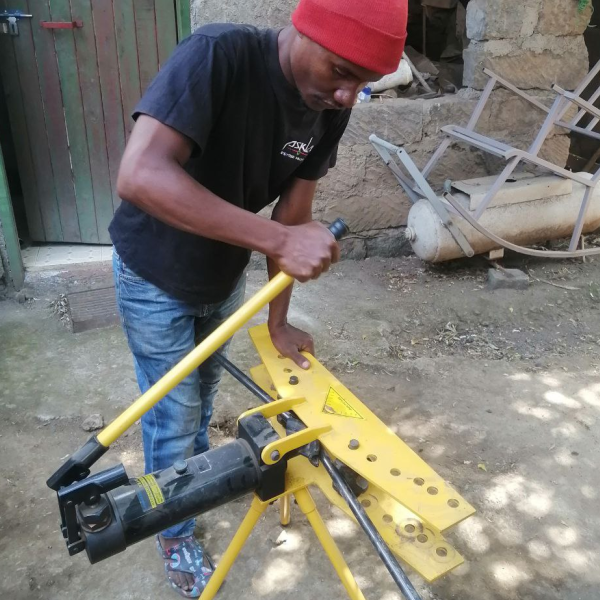
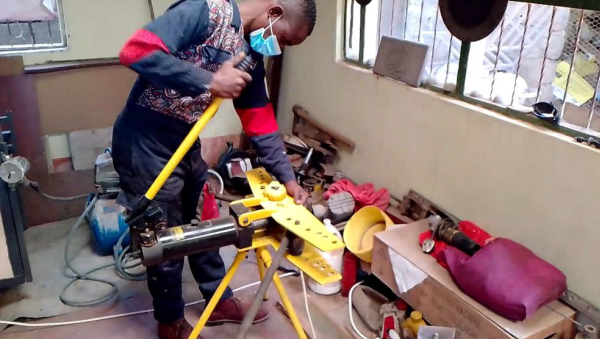

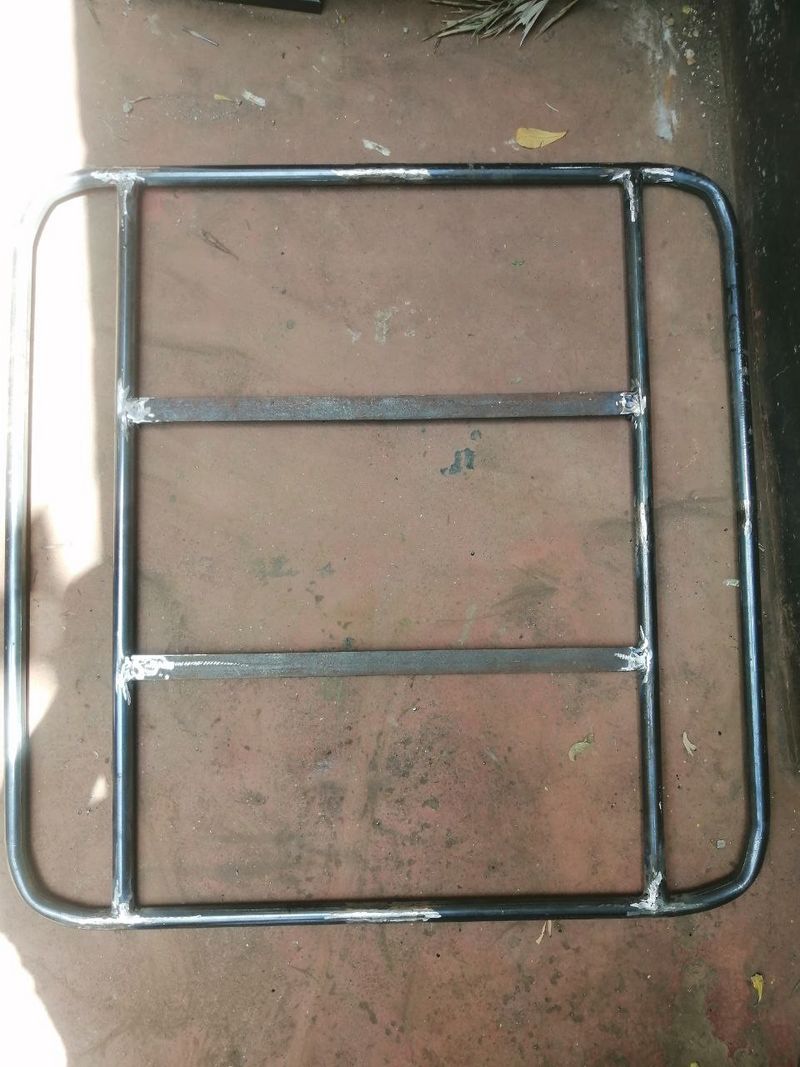

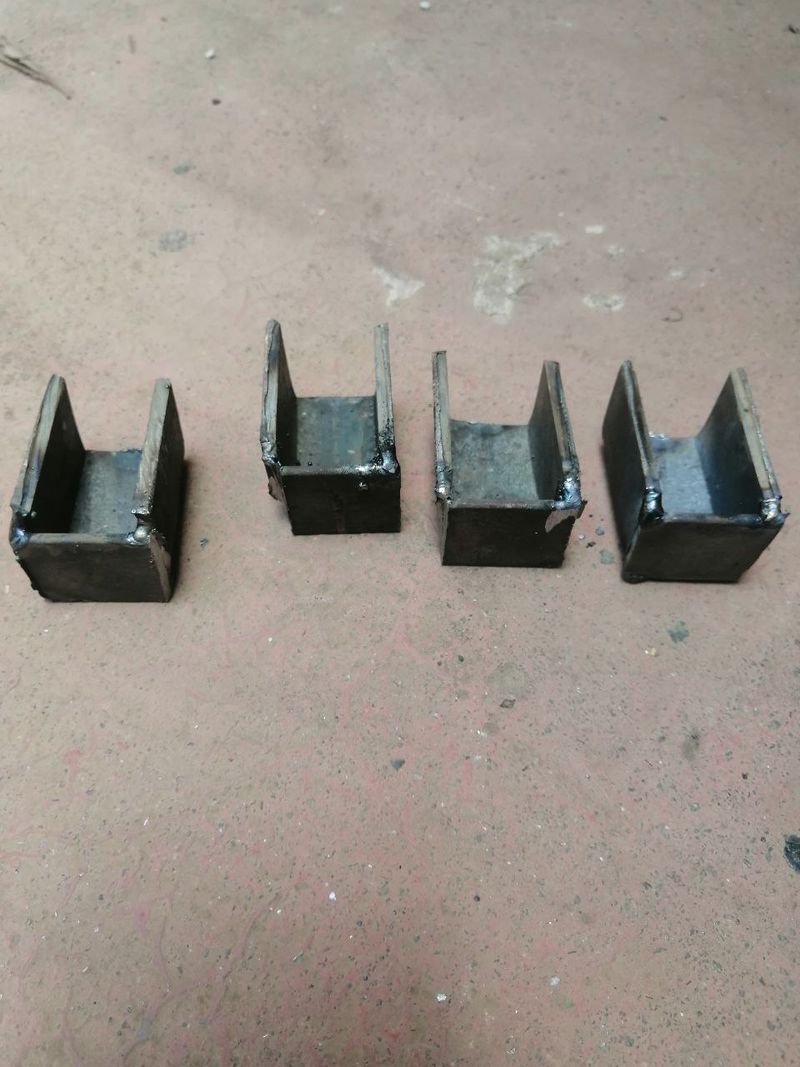
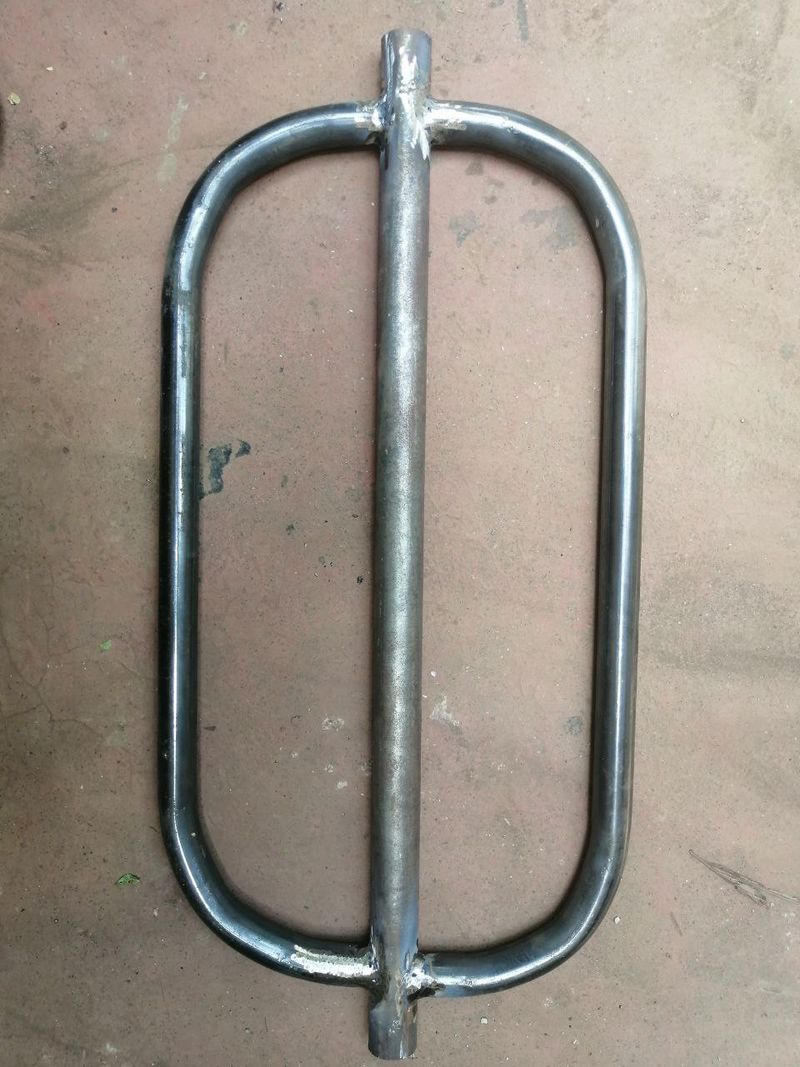

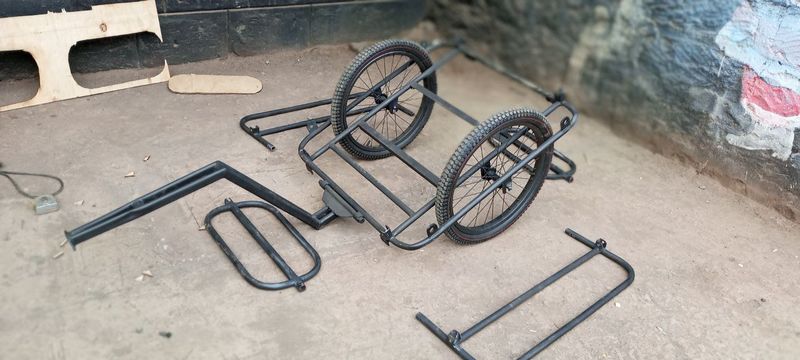


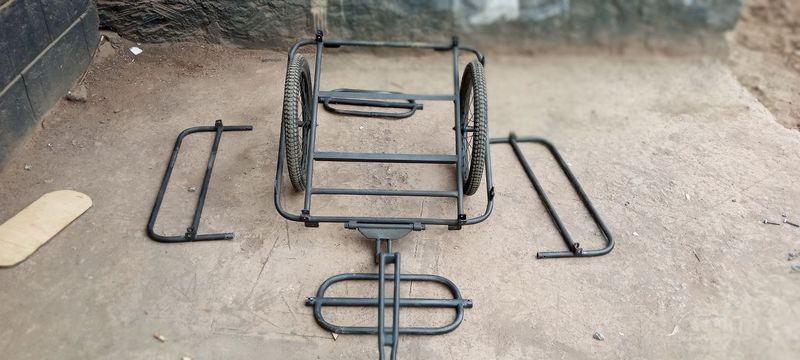
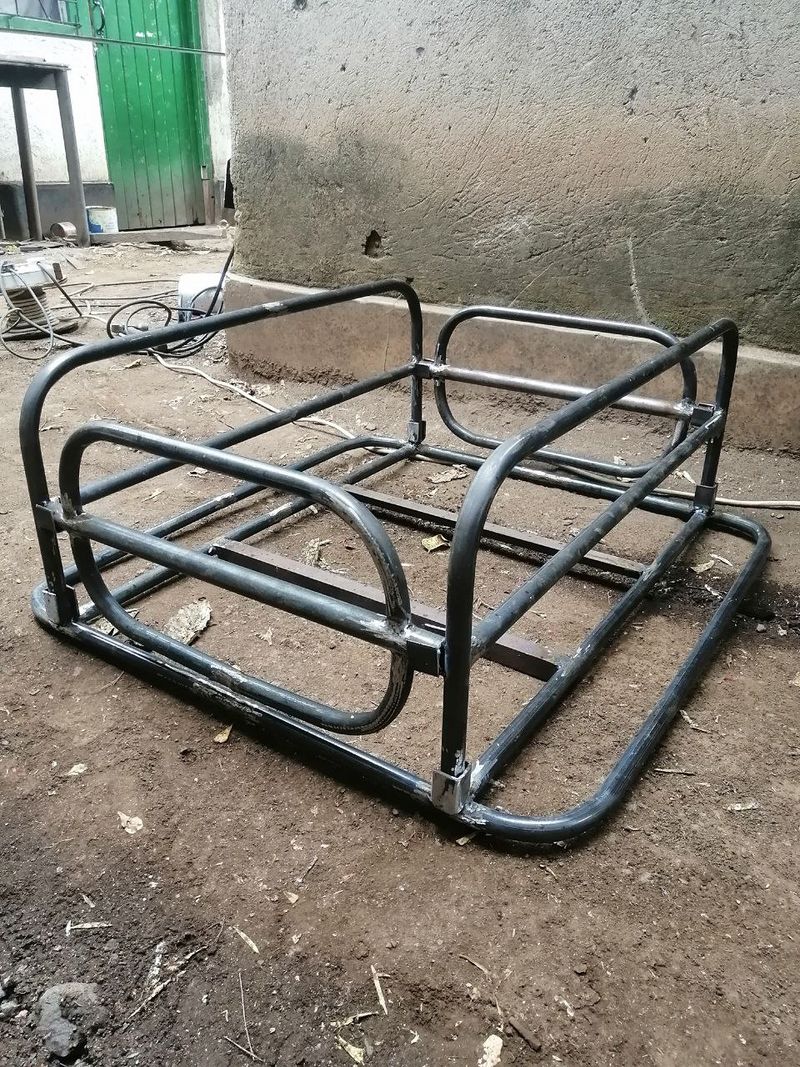


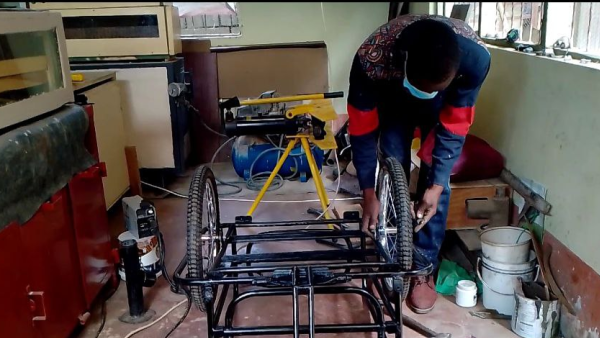
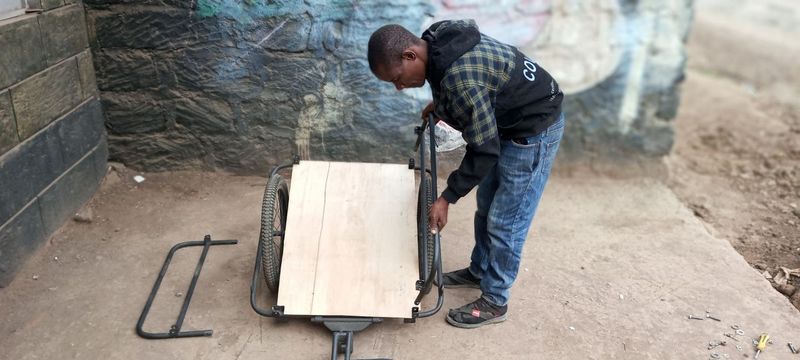
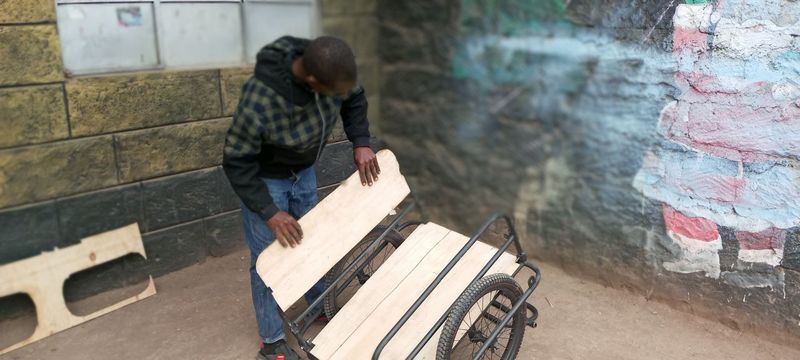

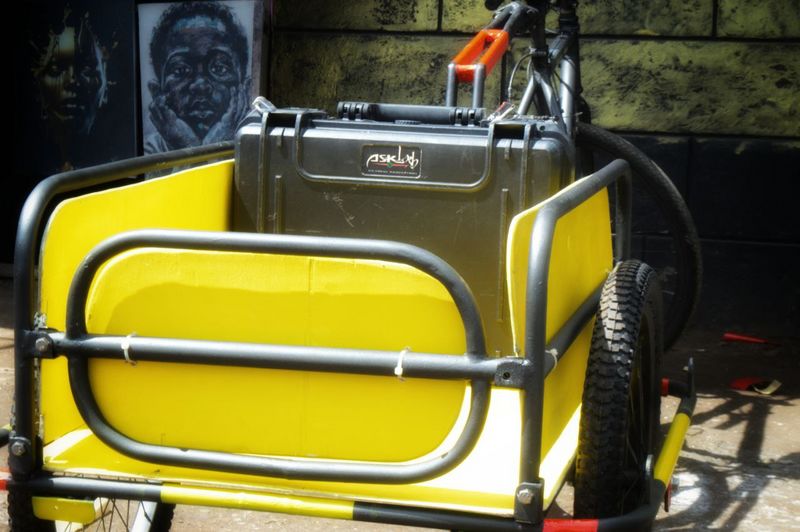

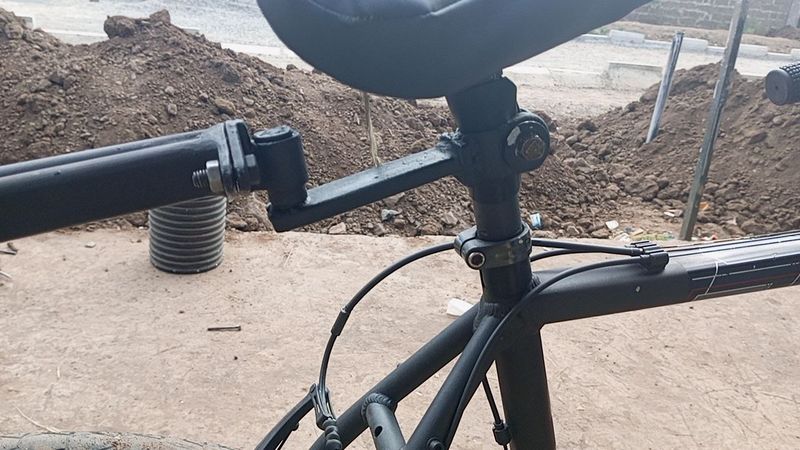
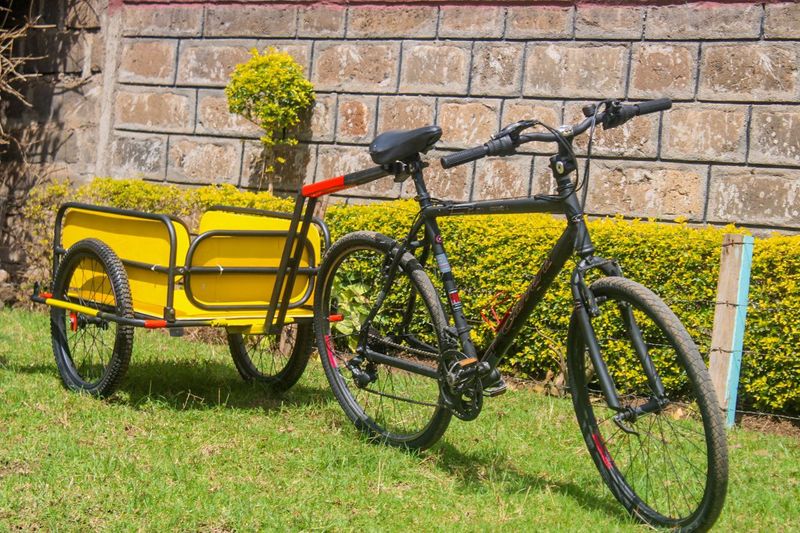

 Français
Français English
English Deutsch
Deutsch Español
Español Italiano
Italiano Português
Português